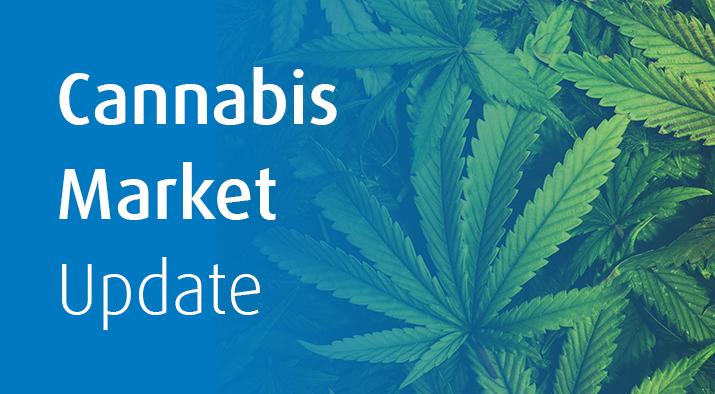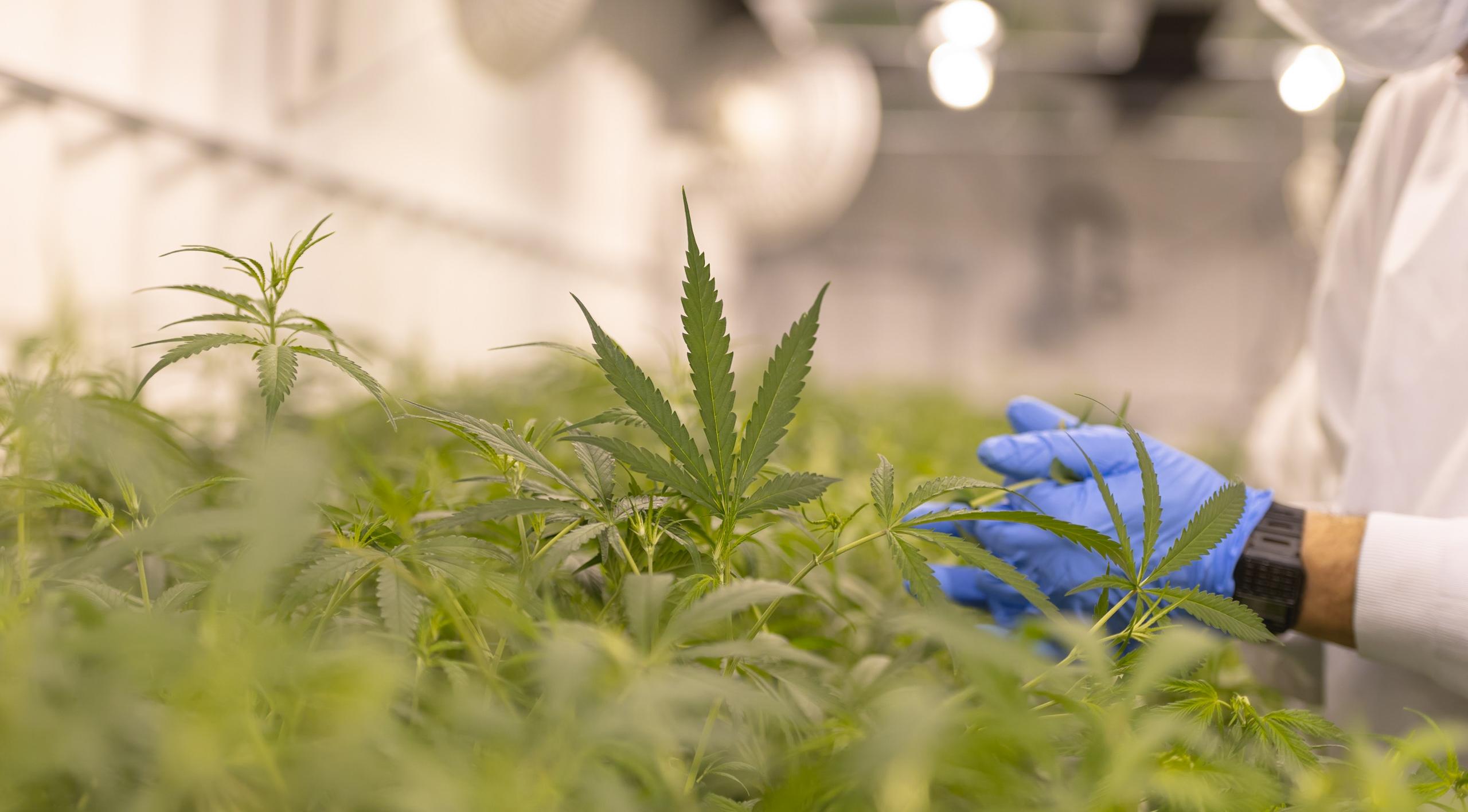
The Cannabis Market Update – Q4 2021
-
bookmark
-
print



Compliments of the season and best wishes for the new year!
Welcome to our inaugural issue of The Cannabis Market Update. Given how rapidly changing the industry is, we wanted to provide you a snapshot of the market – from a view on industry trends and risks to M&A activity to regulatory updates in other markets, retail and 2.0 products. Going forward, we will share periodic updates. Should something you read here grab your attention, reach out with your thoughts or questions. We welcome starting – or continuing – a conversation. We’re here to help you and your business every step of the way, in any way we can.
This issue points out that while Covid-19 cases and high summer vaccination rates led to a stronger than expected recovery, the rising Omicron variant and slower innoculation rates could stifle it. Cannabis sales increased to C$364.2MM in October 2021, a 2.8% increase over September’s sales figure. H1/21dried flower sales stood at 73% compared to 90% in early 2020, highlighting the product’s waning dominance as cannabis 2.0 products gain market share. In September 2020, the Top 5 LPs represented 50% of the market; this figure fell to 38.4% in August 2021.
Macro Highlights
COVID-19
While declining Covid-19 cases and high vaccination rates in the summer led to stronger than expected economic recovery expectations, surging Omicron variant cases in December 2021 led to additional mandated lockdowns on certain businesses and industries.
- Uncertainty exacerbated by future variants.
- Slower global inoculation rates could add to supply chain disruptions and weigh on exports.
Monetary and Fiscal Stimuli/Policy Responses
The Bank of Canada was the first to signal exit from stimulus in April 2021; but the US Fed was not ready to consider scaling back pandemic support. In September however, the Fed indicated it could potentially slow down on its large-scale purchases of government-backed bonds and raise interest rates in 2022.1
Cannabis Industry Overview
Legal Market size
- 2020 size: C$2.6B (Canada); US$17.5B (USA).2
- Expected size by 2026: C$8.6B (Canada)3 and US$41.3B (USA)4
Growth Drivers
- Adoption of cannabis as treatment for chronic and neurological conditions.
- Displacement of the illicit market currently estimated at US$300.0B globally.5
- Product variety, innovation and new products.
Canadian Retail
- Cannabis sales increased to C$364.2MM in October, a 2.8% increase over September’s sales figure; surpassed the C$4.0B annual rate for the first time in July.
- Most gains were driven almost entirely by Ontario where sales grew to C$145.7MM, 3.0% growth m/m; sales dipped 2.8% to C$7.1MM in New Brunswick.6
- As of January 4, 2022, Ontario had 1,358 open licensed cannabis stores and a footprint per capita of 10,983.
US Cannabis
- Medical cannabis legal in 37 states and 4 territories; adult-use cannabis legal in 18 states.
- In July, Senators Schumer, Wyden, and Booker introduced the Cannabis Administration and Opportunity Act, a discussion bill aimed at legalizing cannabis.
- Bill challenges: hyper partisan Congress and Senate filibuster.
Cannabis 2.0 Products
- Sales of most Cannabis 2.0 products continue to grow at a modest pace.
- H1/21 market share breakdown of Cannabis 2.0 products in Canada:
- Dried flower: 73% (C$1.3B), down from 90% in early 2020; Pure Sunfarms leads segment.7
- Extracts and concentrates: 16.4% (C$291.7MM).7
- Edibles: 3.82% (C$68.1MM); Indiva tops7; BDSA, a cannabis-focused market research firm, forecasts the segment to grow to ~ C$1.35B by 2025.8
- Beverages: 1.3% (C$23.6MM); expected to reach 7% (C$603.4MM) of the market in 2026.9
Competitive Landscape
- A growing craft segment within the market has led to mid-size Licensed Producers (LPs) taking significant market share from the larger LPs.
- Nine LPs had 78.7% market share in August 2020; cumulative market share of these LPs dropped to 61.5% in August 2021.
- Top 5 LPs represented 50% of the market in September 2020; represented 38.4% of the market in August 2021.10
- October market share gainers: Auxly, and Organigram; flat/losers: Aurora, Cronos Group, Hexo, Tilray, and Village Farms International.11
Industry Trends
- Acquisition of craft producers by larger LPs given higher margins and greater stickiness of consumers in the former.
- High demand for THC-dominant products persists.
- This is transitioning to high demand for terpenes, flavour, aroma, moisture and physical effects of products as the consumer evolves and becomes more sophisticated.
- Innovative offerings driven by improved consumer loyalty (where and what they buy).
Industry Risks
- Profitability challenges continue; however, some LPs have begun to consistently generate positive EBITDA.
- Stringent branding and advertising regulations negatively impacting sell through.
- Current store saturation potentially leading to looming closures in 2022.
Industry Outlook
- Falling prices and increased product quality driving displacement of the illicit market.
- Interest from ancillary CPG industries like tobacco and alcohol due to high-growth opportunities.
- Increased research leading to enhanced awareness about the benefits of cannabis and cannabinoids other than THC and CBD.
Capital Markets Update
Equity Raises
- US$12.8B was been raised in 2021; US$1.4B lower than in 2018.
- US equity raises up by US$1.9B (60%); debt up by US$3.4B (806%); Canadian equity raises down 76%; debt raises down 12%; capital raises from the rest of the world down 80%.12
M&A
- As part of Tilray’s US expansion strategy, the company:
- Acquired Breckenridge Distillery, a profitable company with strong brands and distribution channels; deal size: US$100MM.
- Will acquire 21% of Medmen should the US legalize cannabis federally; deal size: US$165.8MM.
- Valens acquired Citizen Stash to diversify outside contract manufacturing; deal size: C$54.3MM.
- Canopy Growth to acquire 100% of the outstanding membership interests of Wana upon federal permissibility of THC in the US; deal size: US$297.5MM.
- Village Farms acquired Balanced Health Botanicals to partake in the US’ high THC cannabis market upon legalization; deal size: US$75.0MM.
- Village Farms acquired 70% of Quebec based Rose LifeScience to increase presence in Quebec which represents 15% of the total Canadian retail cannabis sales: deal size: C$46.7MM.
1 https://www.nytimes.com/2021/09/22/business/economy/fed-taper-interest-rate-increase.html![]()
2 https://thcnet.com/news/bdsa-legal-us-cannabis-sales-surpassed-175-billion-in-2020![]()
3 Growing a cannabis market: Brightfield Group
4 https://thcnet.com/news/bdsa-legal-us-cannabis-sales-surpassed-175-billion-in-2020![]()
5 2021-08 – EY Industry Update
6 https://mjbizdaily.com/canadian-recreational-cannabis-sales-grow-to-ca364-2-million-in-october/![]()
7 https://mjbizdaily.com/canadians-bought-ca1-3-billion-of-dried-cannabis-in-first-half-of-2021/![]()
9 Growing a cannabis market: Brightfield Group
10 Aug HiFyre Data: Despite Recent M&A, the Market Has Become More Fragmented, Tamy Chen BMO Capital Markets report
11 Oct HiFyre Data: Could 2022 Be the Year of Retail Closures in Ontario? Tamy Chen BMO Capital Markets report
12 https://www.viridianca.com/deal-tracker/cannabis-deal-tracker-week-52-2021![]()

Allen Benjamin
Managing Director and National Lead, Cannabis & Emerging Industries, Commercial Bank, Canada
Allen is a seasoned professional with 20 years of experience across multiple industries, including financial services, in Canada and the Caribbean. As the…(..)
View Full Profile >Compliments of the season and best wishes for the new year!
Welcome to our inaugural issue of The Cannabis Market Update. Given how rapidly changing the industry is, we wanted to provide you a snapshot of the market – from a view on industry trends and risks to M&A activity to regulatory updates in other markets, retail and 2.0 products. Going forward, we will share periodic updates. Should something you read here grab your attention, reach out with your thoughts or questions. We welcome starting – or continuing – a conversation. We’re here to help you and your business every step of the way, in any way we can.
This issue points out that while Covid-19 cases and high summer vaccination rates led to a stronger than expected recovery, the rising Omicron variant and slower innoculation rates could stifle it. Cannabis sales increased to C$364.2MM in October 2021, a 2.8% increase over September’s sales figure. H1/21dried flower sales stood at 73% compared to 90% in early 2020, highlighting the product’s waning dominance as cannabis 2.0 products gain market share. In September 2020, the Top 5 LPs represented 50% of the market; this figure fell to 38.4% in August 2021.
Macro Highlights
COVID-19
While declining Covid-19 cases and high vaccination rates in the summer led to stronger than expected economic recovery expectations, surging Omicron variant cases in December 2021 led to additional mandated lockdowns on certain businesses and industries.
- Uncertainty exacerbated by future variants.
- Slower global inoculation rates could add to supply chain disruptions and weigh on exports.
Monetary and Fiscal Stimuli/Policy Responses
The Bank of Canada was the first to signal exit from stimulus in April 2021; but the US Fed was not ready to consider scaling back pandemic support. In September however, the Fed indicated it could potentially slow down on its large-scale purchases of government-backed bonds and raise interest rates in 2022.1
Cannabis Industry Overview
Legal Market size
- 2020 size: C$2.6B (Canada); US$17.5B (USA).2
- Expected size by 2026: C$8.6B (Canada)3 and US$41.3B (USA)4
Growth Drivers
- Adoption of cannabis as treatment for chronic and neurological conditions.
- Displacement of the illicit market currently estimated at US$300.0B globally.5
- Product variety, innovation and new products.
Canadian Retail
- Cannabis sales increased to C$364.2MM in October, a 2.8% increase over September’s sales figure; surpassed the C$4.0B annual rate for the first time in July.
- Most gains were driven almost entirely by Ontario where sales grew to C$145.7MM, 3.0% growth m/m; sales dipped 2.8% to C$7.1MM in New Brunswick.6
- As of January 4, 2022, Ontario had 1,358 open licensed cannabis stores and a footprint per capita of 10,983.
US Cannabis
- Medical cannabis legal in 37 states and 4 territories; adult-use cannabis legal in 18 states.
- In July, Senators Schumer, Wyden, and Booker introduced the Cannabis Administration and Opportunity Act, a discussion bill aimed at legalizing cannabis.
- Bill challenges: hyper partisan Congress and Senate filibuster.
Cannabis 2.0 Products
- Sales of most Cannabis 2.0 products continue to grow at a modest pace.
- H1/21 market share breakdown of Cannabis 2.0 products in Canada:
- Dried flower: 73% (C$1.3B), down from 90% in early 2020; Pure Sunfarms leads segment.7
- Extracts and concentrates: 16.4% (C$291.7MM).7
- Edibles: 3.82% (C$68.1MM); Indiva tops7; BDSA, a cannabis-focused market research firm, forecasts the segment to grow to ~ C$1.35B by 2025.8
- Beverages: 1.3% (C$23.6MM); expected to reach 7% (C$603.4MM) of the market in 2026.9
Competitive Landscape
- A growing craft segment within the market has led to mid-size Licensed Producers (LPs) taking significant market share from the larger LPs.
- Nine LPs had 78.7% market share in August 2020; cumulative market share of these LPs dropped to 61.5% in August 2021.
- Top 5 LPs represented 50% of the market in September 2020; represented 38.4% of the market in August 2021.10
- October market share gainers: Auxly, and Organigram; flat/losers: Aurora, Cronos Group, Hexo, Tilray, and Village Farms International.11
Industry Trends
- Acquisition of craft producers by larger LPs given higher margins and greater stickiness of consumers in the former.
- High demand for THC-dominant products persists.
- This is transitioning to high demand for terpenes, flavour, aroma, moisture and physical effects of products as the consumer evolves and becomes more sophisticated.
- Innovative offerings driven by improved consumer loyalty (where and what they buy).
Industry Risks
- Profitability challenges continue; however, some LPs have begun to consistently generate positive EBITDA.
- Stringent branding and advertising regulations negatively impacting sell through.
- Current store saturation potentially leading to looming closures in 2022.
Industry Outlook
- Falling prices and increased product quality driving displacement of the illicit market.
- Interest from ancillary CPG industries like tobacco and alcohol due to high-growth opportunities.
- Increased research leading to enhanced awareness about the benefits of cannabis and cannabinoids other than THC and CBD.
Capital Markets Update
Equity Raises
- US$12.8B was been raised in 2021; US$1.4B lower than in 2018.
- US equity raises up by US$1.9B (60%); debt up by US$3.4B (806%); Canadian equity raises down 76%; debt raises down 12%; capital raises from the rest of the world down 80%.12
M&A
- As part of Tilray’s US expansion strategy, the company:
- Acquired Breckenridge Distillery, a profitable company with strong brands and distribution channels; deal size: US$100MM.
- Will acquire 21% of Medmen should the US legalize cannabis federally; deal size: US$165.8MM.
- Valens acquired Citizen Stash to diversify outside contract manufacturing; deal size: C$54.3MM.
- Canopy Growth to acquire 100% of the outstanding membership interests of Wana upon federal permissibility of THC in the US; deal size: US$297.5MM.
- Village Farms acquired Balanced Health Botanicals to partake in the US’ high THC cannabis market upon legalization; deal size: US$75.0MM.
- Village Farms acquired 70% of Quebec based Rose LifeScience to increase presence in Quebec which represents 15% of the total Canadian retail cannabis sales: deal size: C$46.7MM.
1 https://www.nytimes.com/2021/09/22/business/economy/fed-taper-interest-rate-increase.html![]()
2 https://thcnet.com/news/bdsa-legal-us-cannabis-sales-surpassed-175-billion-in-2020![]()
3 Growing a cannabis market: Brightfield Group
4 https://thcnet.com/news/bdsa-legal-us-cannabis-sales-surpassed-175-billion-in-2020![]()
5 2021-08 – EY Industry Update
6 https://mjbizdaily.com/canadian-recreational-cannabis-sales-grow-to-ca364-2-million-in-october/![]()
7 https://mjbizdaily.com/canadians-bought-ca1-3-billion-of-dried-cannabis-in-first-half-of-2021/![]()
9 Growing a cannabis market: Brightfield Group
10 Aug HiFyre Data: Despite Recent M&A, the Market Has Become More Fragmented, Tamy Chen BMO Capital Markets report
11 Oct HiFyre Data: Could 2022 Be the Year of Retail Closures in Ontario? Tamy Chen BMO Capital Markets report
12 https://www.viridianca.com/deal-tracker/cannabis-deal-tracker-week-52-2021![]()
What to Read Next.
Cannabis Industry: What’s Next?
Allen Benjamin | June 24, 2021 | Agriculture, Cannabis And Emerging Industries

A track dedicated to the cannabis industry at BMO’s 16th Annual Farm to Market Conference in May 2021 featured 13 cannabis companies sharing th…
Continue Reading>Related Insights
Tell us three simple things to
customize your experience






Banking products are subject to approval and are provided in Canada by Bank of Montreal, a CDIC Member.
BMO Commercial Bank is a trade name used in Canada by Bank of Montreal, a CDIC member.
Please note important disclosures for content produced by BMO Capital Markets. BMO Capital Markets Regulatory | BMOCMC Fixed Income Commentary Disclosure | BMOCMC FICC Macro Strategy Commentary Disclosure | Research Disclosure Statements
BMO Capital Markets is a trade name used by BMO Financial Group for the wholesale banking businesses of Bank of Montreal, BMO Bank N.A. (member FDIC), Bank of Montreal Europe p.l.c., and Bank of Montreal (China) Co. Ltd, the institutional broker dealer business of BMO Capital Markets Corp. (Member FINRA and SIPC) and the agency broker dealer business of Clearpool Execution Services, LLC (Member FINRA and SIPC) in the U.S. , and the institutional broker dealer businesses of BMO Nesbitt Burns Inc. (Member Canadian Investment Regulatory Organization and Member Canadian Investor Protection Fund) in Canada and Asia, Bank of Montreal Europe p.l.c. (authorised and regulated by the Central Bank of Ireland) in Europe and BMO Capital Markets Limited (authorised and regulated by the Financial Conduct Authority) in the UK and Australia and carbon credit origination, sustainability advisory services and environmental solutions provided by Bank of Montreal, BMO Radicle Inc., and Carbon Farmers Australia Pty Ltd. (ACN 136 799 221 AFSL 430135) in Australia. "Nesbitt Burns" is a registered trademark of BMO Nesbitt Burns Inc, used under license. "BMO Capital Markets" is a trademark of Bank of Montreal, used under license. "BMO (M-Bar roundel symbol)" is a registered trademark of Bank of Montreal, used under license.
® Registered trademark of Bank of Montreal in the United States, Canada and elsewhere.
™ Trademark of Bank of Montreal in the United States and Canada.
The material contained in articles posted on this website is intended as a general market commentary. The opinions, estimates and projections, if any, contained in these articles are those of the authors and may differ from those of other BMO Commercial Bank employees and affiliates. BMO Commercial Bank endeavors to ensure that the contents have been compiled or derived from sources that it believes to be reliable and which it believes contain information and opinions which are accurate and complete. However, the authors and BMO Commercial Bank take no responsibility for any errors or omissions and do not guarantee their accuracy or completeness. These articles are for informational purposes only.
Bank of Montreal and its affiliates do not provide tax, legal or accounting advice. This material has been prepared for informational purposes only, and is not intended to provide, and should not be relied on for, tax, legal or accounting advice. You should consult your own tax, legal and accounting advisors before engaging in any transaction.
Third party web sites may have privacy and security policies different from BMO. Links to other web sites do not imply the endorsement or approval of such web sites. Please review the privacy and security policies of web sites reached through links from BMO web sites.
Please note important disclosures for content produced by BMO Capital Markets. BMO Capital Markets Regulatory | BMOCMC Fixed Income Commentary Disclosure | BMOCMC FICC Macro Strategy Commentary Disclosure | Research Disclosure Statements




